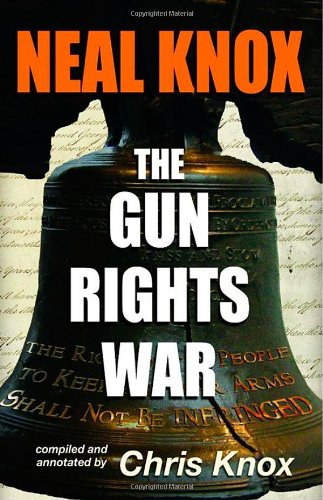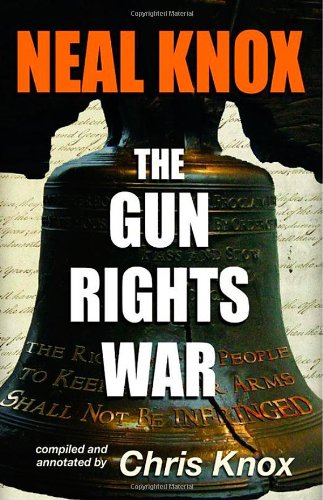Preface by Chris Knox
This piece and the preceding one were written during the run-up to the 1997 NRA Board meeting that would replace Neal Knox with Charlton Heston as NRA First Vice-President. In order to assure Heston’s election, which was not a sure thing (Heston won by a mere four votes), his backers had “gone negative.” The details of the 1997 fight appear later in this section, but in this piece and its preceding companion, Knox looks back needing to protect his name, he ran these two pieces in back-to-back issues of Shotgun News.
April 28, 1997
When the New York Times devotes an editorial to trashing me, I’m honored.
On February 3, 1997 they huffed that “Mr. Knox has been a dark force in the N.R.A. since his days as the group’s chief lobbyist. He was kicked out of that job in 1982 and expelled from the board in 1984 for ‘extremism.’”
As reported in my last column,“extremism” had nothing to do with my firing—not unless it is “extremist” to insist that Sen. Bob Dole and the other 54 co-sponsors of the McClure-Volkmer “Gun Decontrol Act” bring it to a vote and pass it, as they had promised to do.
Similarly my removal from the Board in 1984 had nothing to do with “extremism.”
But it was again tied to my all-out effort to pass the McClure-Volkmer bill, which would have cut the heart out of the Gun Control Act of 1968. I helped write the McClure bill in 1979, and began the ground-work—by declaring war on BATF’s GCA ’68 enforcement tactics—the week after I became ILA Executive Director in January 1978.
The week after I was fired, the Senate Judiciary finally approved the long-stalled McClure-Volkmer bill—but only after adding the Kennedy-Dole amendment calling for a 7-day waiting period on handgun purchases (a concept Dole had been quietly pushing for a couple of years).
Instead of working to remove the Dole-Kennedy amendment, my successor at ILA, J. Warren Cassidy, happily quit supporting McClure-Volkmer. The Senators who didn’t want to vote on it—led by Dole—were relieved.
But NRA members wouldn’t back off. They demanded that NRA and Congress move the bill.
In early 1983 Cassidy took two copies of the bill to Sen. Jim McClure, showing the amendments wanted by the “Reagan Administration” (BATF and the Justice Department). Sen. McClure gave me one of his copies and asked me to give him a report of their effect.
To my astonishment, the modifications weren’t to the original version, but to the committee-passed version—which had the Dole-Kennedy waiting period.
The Administration/BATF amendments gutted the bill. For instance, the heart of GCA ’68 was its prohibition of virtually all interstate transfers. The original M-V eliminated those prohibitions unless the laws of either state restricted such transfers.
I was reared on both sides of the Red River dividing Texas and Oklahoma, and had family in each; neither state restricted my purchase of any type gun. But under GCA ’68 my uncle couldn’t give me a gun without both of us committing a Federal felony.
One of the dozen BATF amendments to M-V would have retained the total prohibition on interstate handgun transfers and allowed long gun purchases only from dealers. At the 1983 members’ meeting in Phoenix, Cassidy claimed he hadn’t asked Sen. McClure to support those amendments—but that’s not what Sen. McClure told me.
Harlon did his best to get the Board not to seat me, saying, “We must excise this cancer.” But he couldn’t get the board to agree. That fall, Cassidy got Sen. Orrin Hatch (R-Utah) to support the BATF amendments. Sen. McClure was furious. I prepared written testimony—as a private citizen—opposing the amendments and presented it to the Senate Judiciary, which wouldn’t let me testify. And I lobbied friends on the Hill, some of whom I had known for 15 years, and probably none of whom knew I was on the NRA Board.
When I blasted Cassidy in Gun Week for supporting the amendments, he denied it, citing weasel-worded committee testimony. Only long after, when the hearing report came out, did I learn that Sen. Thurmond had demanded—and got—a clear written statement in support of the amendments. Late on the night before the January 1984 Board Meeting, I was informally told that there would be an effort to expel me for opposing the position taken by ILA. I received no official notice. The Board voted 45-24 (just short of two-thirds; not the three-quarter vote claimed in a recently distributed letter from four past presidents, all of whom voted against me).
In opposing any amendments to McClure-Volkmer, I was lobbying in support of long-established Board policy.
Board members asked me if I would promise not to do it again; I replied that I could not make such a promise because I couldn’t know if NRA were going to at some future time act against the best interests of the members.
If that be “extremism,” make the most of it.
Used with permission.
Knox, Neal. Neal Knox – The Gun Rights War: Dispatches from the Front Lines 1966 through 2000 . MacFarlane Press. Kindle Edition. Location 5398 – 5432.

The New York Times editorial that is referenced in this excerpt can be found here. It referred to Neal Knox as a “dark force” who wanted to repeal the Brady Law as well as the Clinton assault weapons ban. It said he even wanted to legalize “fully automatic weapons.” The horror!
That editorial noted that Wayne LaPierre was facing a challenge from within due to “declining membership, financial problems and an abysmal public image”. Other than a declining membership, this could have almost been written in 2020. If they had said declining contributions, it would have been spot on.

